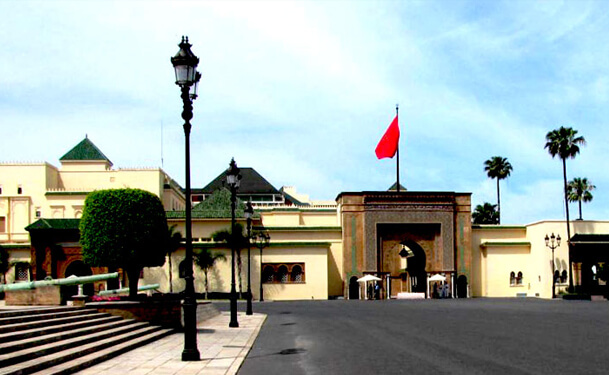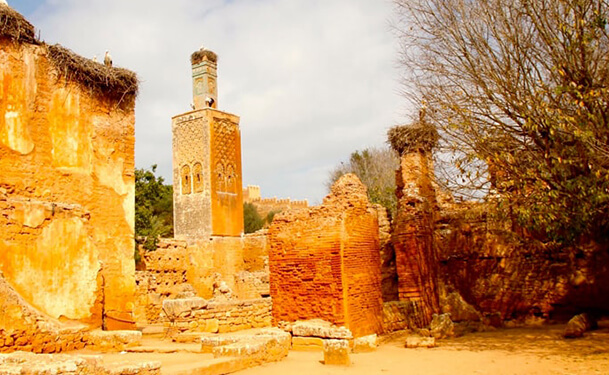The Grand Tour is a circuit that will allow you to discover the charm of the city of Rabat by visiting its places incountournables ...
Longueur: 3.5 KM Durée : 3 H

Spanning an area of about 17 Ha, containing an estimated Floristic richness of more than 600 species, and more than 1000 varieties, the Garden of Botanical Trials is undoubtedly the largest public garden in Rabat. It inspired the creation of Marrakech Botanical Gardens (25 Ha) and Meknes Botanical Gardens (30 Ha).

The gate of departure, is the largest gate of the Almohad enclosure. Its decor is rich and remarkably executed, it’s made up of four rooms (originally bent), of which the first has an interesting fluted dome. It is now converted into an art gallery.

The construction of the royal palace of Rabat began in the middle of the 19th century on the ruins of an ancient palace. Also called Dar El Makhzen, majestic and protective, the building is a fine example of Moroccan art. Surrounded by an enclosure, its main entrance overlooks a vast esplanade, the Mechouar, is used for the outdoors royal ceremonies.

Built in the XIV Century by the Merinid dynasty upon the ruin of the ancient Roman city of Sala Colonia, the Chellah necropolis is located at a distance of two kilometers from the city center, off the Almohad enclosure. According to historians and archeologists, the Chellah site was undoubtedly the most ancient human agglomeration ever set on the estuary of the Bouregreg River. For proof, one can allude to the numerous trading posts founded by the Phoenicians and Carthaginians. Standing on a hilltop which overlooks the river, the Chellah necropolis is a magical space surrounded by a thousand mysteries. Hardly does the visitor walk through the Merinid portal of the city of Chellah, with its octagonal shape, when she immediately plunges into a fairy land where the traces and remnants of the Roman and Merinid empires marvelously mix with each other. A long and pleasant paved road, lined with various trees and odorous flowers meet the visitor. Adorned with polychrome earthenware mosaic, the minaret of the old mosque overlooks the site. Not far from this site lies a pool strewn with coins, where fish, turtles and eels are peacefully swimming.

The Hassan Tower is considered as the symbol of Rabat, it is one of the most famous sites of the kingdom. The Hassan tower remains the only vestige of what was to be, at the instigation of the Almohad sultan Yacoub Al Mansour (12th century), the largest mosque in the Muslim world. This oversized project was not going to survive, at the death of the latter, in the year 1199, nor later, the earthquake of Lisbon in 1755. Only his minaret 44 meters high, very close architecture Koutoubia de Marrakech and the Giralda of Seville survive and give its name to the monument: Hassan Tower.

Right in front of the Hassan Tower stands the mausoleum Mohammed V, a monument of unparalleled beauty.
Its construction began in 1962 and ended in 1971.
This monument is dedicated to the memory of the late monarch Mohammed V, beloved by the people who have always considered the symbol of the Liberation of the Nation.
In the mausoleum one can also see the tomb of his successor, Fire Hassan II and that of his second son, the late Prince Moulay Abdallah. The visit of this monument is a great opportunity to appreciate the true value of traditional Moroccan art.
Outside, a magnificent white marble pavilion crowned with green tiles. Inside, the walls completely covered with “zellige”, the ceiling with its motifs and sculptures on plaster and wood extremely refined demonstrate the ingenuity and know-how of the Moroccan master craftsmen.

Within a fifteen minute walk from the Rabat City Center stands the Casbah of the Oudayas at the Bou Regreg estuary, a real fortress dating back to the XII century. With its monumental Almohade portal, the Kasbah is a gripping site which offers the visitor a never seen before beauty that encompasses the Andalusian style garden, a museum, some riyads and some mosques. The Andalusian influence is omnipresent with the uniformly lime covered walls, the dominant blue colored doors and the wrought iron windows … Inscribed on the World Heritage list by UNESCO, the Kasbah of the Oudayas has become for a good number of both Moroccan and world artists a haven of peace and inspiration. Visitors are seduced by the site’s beauty, just as they are by its soothing calm. Doubtless, the Kasbah’s greatest attraction remains the famous Moorish Café which can be acceded to through the winding streets. The café is a place not to be missed where a mint tea can be enjoyed along with some tasty almond sweets. With the awesome ocean view it offers at the Bou Regreg estuary, the Casbah remains a highly recommended space for relaxation where rowing boats can be seen moving to and fro between the two river banks.

Drawing its name from the fact that it was the residence of foreign diplomats, the Consuls Street is one of the oldest and most famous alleys in the capital. “An inescapable passage in the sightseeing of the capital”. The site has become a landmar.

This souk located between the big mosque and Bab el Bahr, crosses the street of the consuls. Recently restored, it specializes in jewelry…

Souïka Street is the busiest street in the medina. It starts from the Central Market and goes towards the port located in Bab el Bahr, on Bouregreg River. Traditional clothing, fabrics, slippers and other handicrafts are the most common items that.

The Bab El Had gate is part of the Almohad wall, it was built towards the end of the 12th century by Yaacoub El Mansour. El Had means in Arabic the edge of the sword (7ad Essayf). This gate was so named because it was in front of it that murderers were executed, by decapitation by the sword.

Certainly, it is the most beautiful avenue of the capital. It strikes with its beautiful fountain and its many palm trees, and offers the visitors an exceptional walk. It hosts the Parliament with its red facade, the Great Post Office and the Bank.
All you need to guide you in your discovery of the capital. Welcome to the Rabat region.
Find here all the necessary information for a successful stay:
Transports, instructions, climate, plans ...
Discover the interactive map of the region: prepare your trip, visit online the touristic places of the region ...
See the map